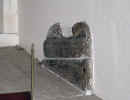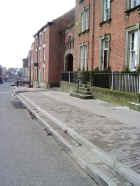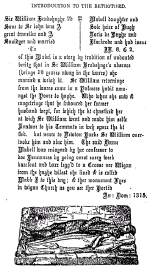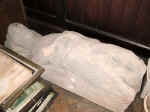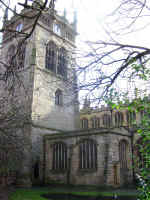| [Back]
[Index]
|
||
"MAB’S CROSS” - LEGEND AND REALITY |
||
by Bob Blakeman |
||
Tomb |
||
The tomb is situated in that part of the church known as the Bradshaigh Chapel, immediately to the south of the chancel. The figures carved there represent Sir William Bradshaigh and Lady Mabel Bradshaigh, who were lord and lady of the manors of Haigh and Blackrod during the fourteenth century. Of the pair, the better known to local people is Lady Mabel, because there Is another monument in the town associated with her, namely Mab’s Cross.
|
||
Cross |
||
(Click here for larger picture) There were once many similar crosses in south Lancashire. Over one hundred and fifty appear on the series of six-inch Ordnance Survey maps published in 1846-7. Such crosses marked the boundaries of lands belonging to monasteries. It was the practice in the Middle Ages for landowners to donate land to monasteries in the belief that they would thereby lessen the sufferings of their souls in purgatory. The earliest surviving mention of the cross in Standishgate Is dated 1277. No particular name is given, and as this date is some time before the birth of Lady Mabel, the question arises: what was the original name of the cross? A map of Wigan published by Mather in 1827 may give us a clue. Near the cross is a field called White Cross Hey. "White Cross" was a common name for wayside crosses, and was given either because the cross was made of a light-coloured stone, or because It marked the lands of monks whose distinctive costume was a white habit.
|
||
Legend |
||
Mab's Cross is famous because of the legend attached to It. The tale exists in two versions. The shorter of the two appears on a document known as the Bradshaigh Roll. This is an ornamental pedigree of the Bradshaigh family drawn up by Randle Holme of Chester in 1647. It tells how Sir William Bradshaigh of Westleigh married Mabel le Norreys, heiress of Haigh. Later Sir William went to fight in the 'Holy Wars' and was absent for ten years. Having no news of him Lady Mabel assumed that he was dead and married a Welsh knight. Eventually Sir William returned home dressed as a palmer, that is, a pilgrim who had made the long and hazardous journey to the Holy Land and carried, as evidence, a staff to which was attached a palm leaf. He also carried a large bag which hung over his shoulder by a thong, and in which he would put the food he had begged along the way. He also wore a long cloak which reached to his feet, and which was used as a blanket at night. When Lady Mabel saw him, she was immediately reminded of her first husband, and wept openly. Seeing this, the Welsh knight asked her the reason, and when she told him he struck her. Sir William, however, restrained himself and did nothing. But that night, he made himself known to his tenants. Hearing of this, the Welsh knight fled, but Sir William pursued him and killed him near the deer park at Newton-le-Willows. Lady Mabel, as a penance for her bigamy, walked barefoot once a week from Haigh Hall to the cross in Standishgate. The longer version appears in the 'Norris Declaration', which was written by Sir William Norris of Speke in 1564. It has some additions to the shorter version, including the following anecdote: Lady Mabel was ignorant of the fact that she was the heiress of
Haigh, Blackrod and Westleigh. By some means or other Sir William discovered this.
He sought her out, and found her cooking oatcakes in an oven (it being a year of famine).
He said, "Maid, if thou wilt marry me, I will make thee lady of Haigh, Blackrod and
Westleigh." She consented, and they were married. In this version Sir William
is absent for seven years only, and on a pilgrimage, not in the 'Holy Wars'. The
Welsh knights' name is given as Henry Teuther, and Sir William reveals himself to his
tenants by showing a mark on his rib. After killing the Welsh knight, Sir William
rides to London and confesses his crime to the king, who pardons him. Strangely, no
mention is made in this version of Lady Mabel's penance at the cross. The story has always held a fascination for historians. It
first appeared in print in Wooton's English Baronets in 1727. The book gives histories of
various landed families. It next appeared in the European Magazine of November 1812,
in a version written by Thomas Whitehouse, an amateur historian of Wigan. Sir Walter Scott
used it in two of his novels: Waverley, published in 1814, and The Betrothed,
published in 1825. In the latter there is a woodcut of the Bradshaigh monument.
(Fig. 2) Scott also said that the story was portrayed in stained glass in the old Haigh
Hall (demolished c. 1850). The building also had a gallery known as Mab's
Gallery, which was supposed to be haunted by the ghost of Lady Mabel, and was flanked by
an ancient chapel and a confession room. In addition, Scott reported that in his time a
ruined building stood near the cross in which Lady Mabel is supposed to have said her
prayers.
|
||
Reality |
||
The first attempt to connect the legend with actual historical events was made by John Roby, a Wigan-born amateur historian, and writer of folk tales. His "Traditions of Lancashire" was published in 1829, and went into many editions. He realised that the long absence of Sir William must have had some connection with the troubled state of Lancashire at the time: the raids by Scottish armies, and the rebellion of the Earl of Lancaster against King Edward II. But it was Rev. Thomas C. Porteus, Vicar of Coppull from 1912 to 1934, and afterwards of St. George's Chorley, who discovered the truth behind the legend. His findings appeared in several papers published by the Lancashire and Cheshire Antiquarian Society during the Second World War. One of the chief sources of information about the condition of Lancashire at this time is a document in the British Museum known as Coram Rege Roll Ho. 254. It consists of 34 sheets of parchment of varying sizes tied together with thong, and gives details of proceedings at a special court held in Wigan in October 1323, at the instigation of King Edward II, in an attempt to restore order to a region that had suffered social anarchy for several years. The name of Sir William Bradshaigh appears frequently in the records. He married Mabel Norris, heiress of Haigh and Blackrod some time before 1295. Sir William's father was Mabel's guardian, and they may have married as children, as is the custom in feudal societies, where marriage is used as a means of acquiring land.
|
||
Revolt |
||
In order to understand what happened in Lancashire we have to be aware of the condition of England at this time. Although England was a monarchy, the kings did not have the absolute power of later monarchs: they faced opposition from powerful barons. The conflict between the barons and the monarchy came to a head during the reign of Edward II. Lancashire was affected by this conflict because the leader of the baronial opposition was Thomas, Earl of Lancaster. Thomas was a quarrelsome individual, with a knack of making enemies, and an inability to inspire loyalty from those who shared his alms. He was also the most powerful baron born in England, having later inherited the earldoms of Lincoln and Salisbury. Edward II was the kind of king that the history books describe as "pleasure-loving": he had little interest in governing the country, and he appointed his friends to do this for him. The barons, however, considered they had a right to be involved in the government, and in February 1310, Lancaster, Pembroke, and some other barons forced the King to banish his chief favourite, Piers Gaveston. However, the king later invited him to return and restored his estates to him. The barons revolted, Gaveston was forced by circumstance to surrender to them, but only on condition that his safety was guaranteed while he left the country. However, Lancaster was instrumental in having him beheaded. Among the knights who took part in this revolt by Lancaster were Sir William Bradshaigh and Sir Adam Banastre of Bretherton, who also held lands in Shevington, AdIington, and Duxbury. These were soon to turn against him. The king had now reached the nadir of his power. His army had been decimated by the Scots at Bannockburn on 24th June 1314. Lancaster was now the virtual ruler of the country, but he proved himself incapable of governing it. He was unable to prevent Robert the Bruce plundering Northumberland and Cumbria in 1315 and 1316. Observing the success of the Scots, the Irish and Welsh also revolted against their English overlords. The country was also suffering from natural calamities. Almost continual rain during the years 1314-1316 caused floods and crops to fall. Parliament tried to limit the price of bread, but merchants merely hoarded grain. Noblemen dismissed retainers they could not feed, and these often turned to banditry to survive.
|
||
Rebellion |
||
Lancashire was a microcosm of the country as a whole. Just as the King rewarded his favourites with positions of wealth and power, so the Earl of Lancaster did in the lands he controlled, often impinging upon or overriding the hereditary rights of others. Lancaster's chief retainer and the principal beneficiary of his generosity was Robert de Holland. Holland was the head of a large and powerful Lancashire family. He held the manor of Upholland and several others in south Lancashire. It was he who founded Upholland Priory in 1310, the remains of which form part of the church there. The priory was originally occupied by secular canons, but they quarrelled with the founder and were replaced by Benedictine monks. The priory was never finished, but some idea of its planned size may be gauged from the fact that the nave of the present church was the priory's chancel. Holland, too, gave lands and privileges to his friends, and so the ladder of corruption extended from the highest to the lowest stratum of society. The outcome of all this was a revolt by those knights and officials who felt that their power in the region was under threat. The leaders of the revolt were Sir William Bradshaigh, Sir Henry Lea of Charnock Richard and Sir Adam Banastre. The rising became known as the 'Banastre Rebellion'. On 8th October 1315 these knights and several others met at Wingates near Westhoughton, and swore revenge against the Holland faction. They then began a campaign against Holland and his supporters. First, they sent a group of armed men to Radcliffe to capture Adam de Radcliffe and his brothers. Adam was taken at the Parsonage, but, falling to find his brothers, they went to the manor house of Sir Henry de Bury to see if they were there. Falling to find them, they murdered Sir Henry, and stole his horse. The next day the rebels were joined at Standish by Sir Ralph de Bickerstaffe and his men. They then proceeded to Wigan where the Rector, who was also lord of the manor, was a Holland supporter. During the rising against Gaveston the Rector had sent two horsemen and "four strong and able footmen, armed with swords, knives, bows and arrows" in aid of the Earl of Lancaster. He told the congregation of Wigan church that they were liegemen of the Earl, and bound to support him against the King. Those who went to fight for Lancaster were promised absolution of their sins. He must have had some success for the records state that "many who previously had no intention of going, did go". The rebels raided the farm of the Rector's bailiffe, John del Crosse, and took away cattle, grain and other goods. They then proceeded to Norley Hall, the home of Thurstan de Norley, another of Lancaster's adherents. There exists a description of the hall in a terrier of the time; it was probably typical of other manor houses in the region. It consisted of a great hall with four rooms off, namely, a bedroom for the lord and lady, a pantry, a kitchen, and a bakehouse. Beneath was a wine cellar. The outhouses consisted of a barn and a shippon for twenty cows. Near the buildings were a vegetable garden, a herb garden, an apple orchard, and two acres of uncultivated land containing various trees. From this homestead the rebels drove away sixteen oxen, and twelve cows, and several carts piled high with household and farm goods. From Wigan the rebels ranged across south Lancashire, raiding the manors of Holland's supporters. They claimed to be acting on the King's behalf, and carried before them a royal banner they had stolen from Manchester church. They captured Halton Castle, over the county boundary in Cheshire, by burning down the gates. They attacked, but failed to take, Liverpool Castle. They succeeded in taking Clitheroe Castle before proceeding to Preston, where they rode through the town, terrorizing the inhabitants.
|
||
Outlaw |
||
But meanwhile the opposition was organising. Edmund de Neville, the Deputy Sheriff of Lancashire, gathered a force of several hundred Lancaster partisans north of the Ribble. The two forces clashed at Deepdale in Preston. The battle lasted less than an hour, and Banastre and the rebels were routed, but he and Sir William Bradshaigh managed to escape. Neville was soon joined by more Lancaster supporters, including Sir Robert de Holland, and with a force of about two thousand men be moved southwards, searching for fugitive rebels and killing them, and extorting property and money from their supporters. Adam Banastre had taken refuge at the house of Henry de Enfurlong at Charnock Richard, but he was betrayed, and Neville had him beheaded. Thurstan de Norley took revenge for the attack on his house by stealing Banastre's weapons, armour, and rosary beads. The Holland faction was now in control, and for the next five or six years they robbed and murdered with impunity. But where was Sir William? Probably he was in Wales, which was the nearest foreign country to Lancashire. Certainly Neville thought Banastre was there, before he was captured, because the Deputy Sheriff ordered the justices of Chester and North Wales to arrest him if he could be found in their bailiwicks. Sir William was outlawed, and his estates forfeited to the King's representative, the Sheriff, for a year and a day. Haigh was leased to a certain Peter de Livesey. Lady Mabel appears to have resisted the forfeiture, for the records state that she "intruded herself" on Livesey's new acquisition. By 1319 Sir William was generally believed to be dead, for a lawsuit over the manor of Anderton in that year twice states that he was no longer alive.
|
||
Execution |
||
In the summer following the defeat of Banastre and the other rebels, Robert the Bruce again invaded England, but Lancaster was unable to offer any effective resistance, partly because he was engaged in a minor war with his neighbour in Yorkshire, Earl Warenne, and partly because of his continuing dispute with the King. After various political and military manoeuvrings, Lancaster's army was defeated by the King's forces at the battle of Boroughbridge on 16th March 1322. Lancaster himself was captured, taken to the King at Pontefract Castle, condemned to death without a chance to defend himself, and, five days after his defeat, beheaded in public on a hill near the castle. Strange to relate, this unlikeable man, after his death, became a popular hero. An attempt was made to have him canonised, and a hermitage was built on the site of his execution. Lancaster's defeat at Boroughbridge was caused by the fact that so many of his allies deserted him. At the last moment, Robert de Holland, seeing that Lancaster's forces were hopelessly outnumbered, took his men over to the King's side. He was thus a traitor to the lord who had been so generous to him, and went over to the King too late to receive the King's trust. Edward, holding his loyalty suspect, had him imprisoned in Dover Castle.
|
||
Return |
||
The political situation in Lancashire had now been completely transformed. Wherever he was, Sir William Bradshaigh heard of the events and returned to claim his estates and take revenge on his enemies. We can imagine the joy of Lady Mabel in seeing once again the husband she believed was dead. It is interesting to note, in view of the fact that the legend states that Sir William returned dressed as a palmer, that one of the retainers who came back with him was a certain Henry de Palmer. The feud, however, was not over. The leadership of the Holland faction fell to Sir Richard Holland, of Cayley, near Haydock. In January 1323 Sir William and Sir Richard met in Newton-le-Willows, and in the ensuing fight two of Sir Richard's horses were stolen, and his squire wounded. The acts of violence which followed are too numerous to relate in detail: a few examples must suffice. There was a small castle at Blackrod, occupied by Sir William Bradshaigh, which was attacked by Sir Richard de Holland and thirty of his men. The attacker, however, withdrew, after two of them were killed by the defenders arrows. The retainers of the various knights fought and robbed each other whenever they could. At Easter 1323, John the reeve or foreman of the Norley estate, together with several accomplices stole one of Bradshaigh's horses in Wigan. It was loaded with goods worth twenty shillings at the time. On July 22nd of the same year, the same men stole another three of Bradshaigh's horses at Newton-le-Willows. A group of Bradshaigh's men then went to Pemberton, searched out the reeve, and, according to the court records, "beat, wounded and ill-treated him against the King's peace." Meanwhile King Edward had signed a peace treaty with the Scots, and he moved into Lancashire to restore order. He commanded the arrest of Sir William Bradshaigh and Sir Richard de Holland. The trials were held at Wigan in October, but it is not known whether the King attended in person. He certainly stayed at the forfeited manor house of Sir Robert de Holland at Upholland for a few days, before moving on to Liverpool. Bradshaigh was arrested and convicted. Blackrod was taken into the King's possession and Haigh leased to two men, one of whom was Adam de Bradshaigh, the brother of Sir William. He is described as "of Aspull", and may have lived at what is now Bradshaigh Hall Farm, a former moated site in Hall Lane, Aspull, near Pennington Green. Sir William was held prisoner in Kenilworth, and later Pontefract Castle until August 1324, when he was freed on surety of £200, and his property restored to him.
|
||
Bloody Revenge |
||
Very soon events of national importance were to determine the future of those involved in the local story. In September 1326, King Edward's wife, Queen Isabella, and her lover Earl Mortimer, invaded England from France, deposed Edward II, and had his young son crowned Edward III, while maintaining power themselves. After the execution of Thomas, Earl of Lancaster in 1322, his lands became subject to attaint; that is, they were forfeited to the Crown, and the Earl's heirs were disinherited. But Isabella and Mortimer had the attaint annulled, and the earldom passed to Thomas' brother, Henry. The new rulers also released Sir Robert de Holland, and restored his estates to him in 1327. However, the new Earl had never forgiven him for betraying Thomas, and on 15 October 1328 Henry's men killed him in a wood near Henley, and had his head sent to the Earl. Both of Sir William Bradshaigh's chief enemies were now dead, but time was running out for him too. On 16 August 1333, at a place called Hawkstone Edge, at Newton-le-Willows, he was killed in a fight with members of the Radcliffe family. It was the attack by Sir William and others on the Radcliffe family eighteen years before that had begun the Banastre Rebellion. The Radcliffes at last had their revenge. So it was not a Welsh knight who was killed at Newton-le-Willows, but Sir William himself. Although the name Hawkstone Edge is no longer in use, there is, in Mill Lane, a small green boulder set into the pavement, which is known as 'The Bloody Stone', and according to current legend Sir William killed the Welsh knight here. The word "edge" can sometimes mean a boundary, and the stone marked the boundary of Newton Deer Park, so it is almost certain that this is the exact spot of Sir William's death. The Royal Court was held in Wigan again in 1334, and Lady Mabel appeared and accused thirty three men of complicity in the death of her husband of whom only one was convicted and hung. His name was William Mose of Westleigh. He was a man of no social standing or influence: he was expendable. Such an occurrence was not unusual. Medieval society was a network of relationships of kinship and vassalage; the Judicial machinery was weak, and conviction rates were low: between 20% and 30%. Although according to the letter of the law sentences could be brutal, in reality they were usually light, and it was the less powerful and influential who were usually convicted.
|
||
Chantries |
||
After Sir William's death, Lady Mabel seems to have turned to religion. She founded two chantries, one at Blackrod, and one in Wigan parish church, in 1338. A Chantry was a chapel, either a separate building or an annexe to an existing church, set aside as a place in which mass was said to relieve the sufferings of souls in purgatory. Lady Mabel left lands in Wigan and Haigh, the rents from which were to provide the stipend for the chantry priest. Such priests were often younger sons of the founder's family, but as Sir William and Lady Mabel had no children, a certain John de Sutton was appointed the first priest at the Wigan chantry. Lady Mabel directed him and his successors to say mass for the souls of the former King, Edward II, who had died in prison, probably by violence; her late husband Sir William; the late Bishop of Lichfleld (south Lancashire at that time being part of the diocese of Lichfleld); all the faithful departed (which was the usual formula); and, after her death, herself. Lady Mabel probably died in 1348, at the time of the Black Death, and her body was presumably laid in the tomb in the Bradshaigh Chapel. Mass was said in this chapel for two hundred years, until the chantries were closed during the reign of King Edward VI, as part of the Protestant Reformation. The endowments were bought from the Crown by John Kitchen, a speculator in privatised church property. The chantry priest at the time of the dissolution was Hugh Cookson, aged forty-six. He received a pension of £3 0s 3d per year, which was 5 shillings a year less than his usual income. In this he fared better than most other chantry priests. The
chapel itself reverted to the Bradshaigh family, but, sad to say, they neglected it, and
by 1620 it was in a ruinous condition, and open to the weather, and was not restored until
1712. The effigies on the tomb suffered much from weathering, and were described by
John Roby in 1829 as "unshapely masses". In addition the tomb was moved several
times over the centuries. In 1845, as a preliminary to rebuilding the church, the
chancel and the Bradshaigh Chapel were taken down, and the chapel was But there is another possibility. In the middle of the ante-room floor is a large stone flag on which is incised a circle eighteen inches in diameter. Inside the circle is the image of a winged hourglass, on top of which is a skull and crossbones. When struck, this stone gave off a hollow sound, and the police officer in charge of the inspection suggested that there may be another vault beneath. The remains of Sir William and Lady Mabel may be here. Although there is no documentary evidence that Lady Mabel ever did penance at the cross, the fact that one side of her tomb, had, carved in bas-relief, the figure of a woman kneeling before a wayside cross; together with the fact that the cross in Standishgate was known as Mab's Cross a mere fifty years after her death, suggest a real connection with it, although it is unlikely she did penance for bigamy because there is no evidence that she ever married again. The legend of Mab's Cross may be a tale of marital infidelity, but the truth behind it is of a couple who in an age in which treachery and deceit were common, stood by each other through the vicissitudes of a turbulent life. |
||
Bob Blakeman 1989
|
||
BIBLIOGRAGRAPHY |
||
| COLLING, J.O. | The Parish Church of All Saints, Wigan: a short history and guide. n.i. 1957 | |
| HAWKES, Arthur J. | Medieval history of Pemberton: the Norley Hall estate in 1466. Wigan Examiner 1951 | |
| MIDMER, Roy | English medieval monastries (1066-1540): a summary. Heinemann 1979. | |
| PORTEUS, Thomas C. | The Mab's Cross Legend and the Mysterious murder of Sir William de Bradshaigh together with the Foundation charters of the chantry of the Blessed Virgin Mary In the Wigan Parish Church, 1338. Reprinted from the Transactions of the Lancashire and Cheshire Antiquarian Society Volumes LV & LVI. The Society. 1945 | |
| TAYLOR, Henry | The Ancient crosses and holy wells of Lancashire. Sherrat & Hughes. 1906. | |
| TUPLING, G.H. | South Lancashire In the reign of Edward II, as illustrated by the pleas at Wigan recorded in Coram Rege Roll no 254. Chetham Society. 1949. | |
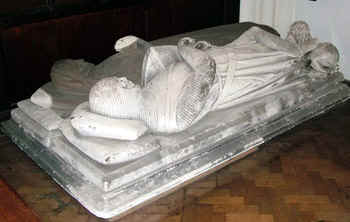 In Wigan Parish Church is the lid of an
antique tomb.
In Wigan Parish Church is the lid of an
antique tomb.